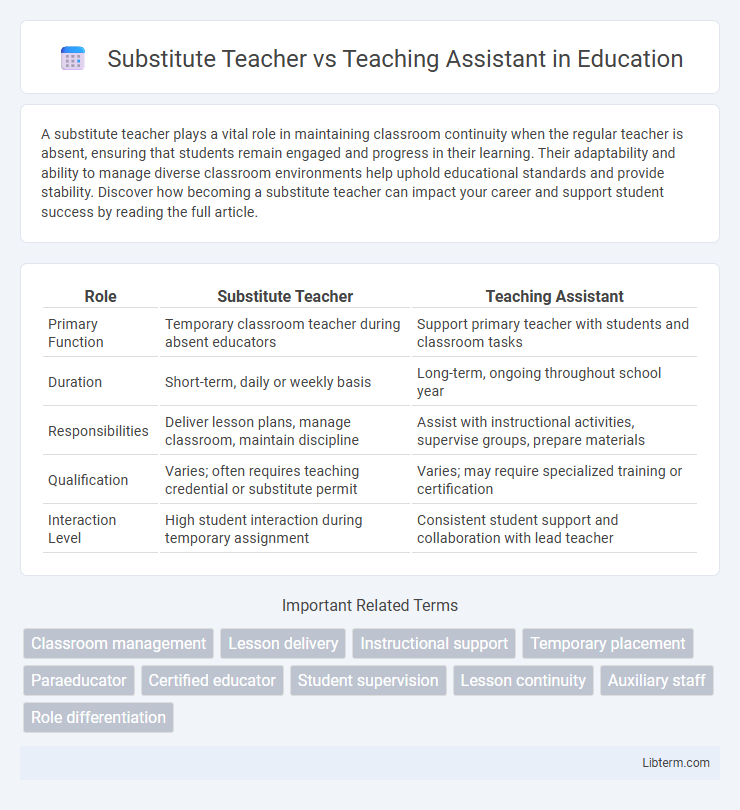A substitute teacher plays a vital role in maintaining classroom continuity when the regular teacher is absent, ensuring that students remain engaged and progress in their learning. Their adaptability and ability to manage diverse classroom environments help uphold educational standards and provide stability. Discover how becoming a substitute teacher can impact your career and support student success by reading the full article.
Table of Comparison
| Role | Substitute Teacher | Teaching Assistant |
|---|---|---|
| Primary Function | Temporary classroom teacher during absent educators | Support primary teacher with students and classroom tasks |
| Duration | Short-term, daily or weekly basis | Long-term, ongoing throughout school year |
| Responsibilities | Deliver lesson plans, manage classroom, maintain discipline | Assist with instructional activities, supervise groups, prepare materials |
| Qualification | Varies; often requires teaching credential or substitute permit | Varies; may require specialized training or certification |
| Interaction Level | High student interaction during temporary assignment | Consistent student support and collaboration with lead teacher |
Understanding Substitute Teachers and Teaching Assistants
Substitute teachers temporarily take over the full responsibilities of classroom teachers, delivering lessons and managing student behavior across various subjects and grade levels. Teaching assistants support lead teachers by providing targeted help to individual students or small groups, assisting with classroom management, and preparing instructional materials. Understanding the distinct roles clarifies their contributions: substitutes ensure continuity in instruction during teacher absences, while teaching assistants enhance learning through ongoing personalized support.
Key Roles and Responsibilities
Substitute teachers assume full classroom management and deliver lesson plans in the absence of the regular teacher, ensuring continuity in student learning and behavior oversight. Teaching assistants support lead teachers by providing individualized student assistance, preparing materials, and managing small group activities to enhance instructional effectiveness. Both roles are critical in maintaining educational environments but differ in scope, with substitutes focusing on temporary classroom leadership and assistants emphasizing collaborative support.
Qualifications and Training Requirements
Substitute teachers typically require a minimum of a bachelor's degree and state certification or licensure to ensure readiness to manage classrooms independently. Teaching assistants, however, often need a high school diploma or associate degree, with some states mandating specialized training or certification focused on supporting instructional activities and student needs. Both roles demand continuing education and training aligned with state regulations to maintain effectiveness and compliance in educational settings.
Typical Work Environments
Substitute teachers commonly work in various public or private school settings, filling in for absent educators across elementary, middle, and high schools, often navigating different classrooms and grade levels daily. Teaching assistants are typically found in more stable environments, such as a single classroom or specialized educational program, providing consistent support to lead teachers in primary or special education settings. Both roles are integral to classroom management but differ in workplace stability and interaction dynamics.
Day-to-Day Duties and Expectations
Substitute teachers are responsible for managing the entire classroom, delivering lesson plans, and maintaining order during a teacher's absence, ensuring continuity in instruction. Teaching assistants support lead teachers by helping with classroom management, assisting individual students, and preparing materials but typically do not lead lessons. The expectation for substitutes includes adapting quickly to different classrooms and subjects, while teaching assistants focus on supporting daily instructional activities and addressing specific student needs.
Interaction with Students and Staff
Substitute teachers engage with students by managing classroom activities and maintaining lesson continuity, often adapting to different teaching styles and student needs with limited preparation time. Teaching assistants work closely with both teachers and students, providing ongoing support by reinforcing lessons, assisting with individualized instruction, and facilitating communication between staff and learners. The substitute teacher's role is typically temporary and authoritative, while teaching assistants have a consistent presence, enhancing collaboration within the educational environment.
Job Flexibility and Work Hours
Substitute teachers typically enjoy greater job flexibility, working on an as-needed basis without a fixed schedule, allowing them to accept assignments that fit their availability. Teaching assistants often have more consistent work hours aligned with the school's daily timetable, providing a structured routine but less flexibility. Both roles require adaptability, but substitute teachers benefit from varying placements, while teaching assistants maintain steady engagement within a single classroom.
Salary and Benefits Comparison
Substitute teachers typically earn higher hourly wages than teaching assistants, with average rates ranging from $100 to $200 per day depending on the district, while teaching assistants usually receive an annual salary between $25,000 and $40,000. Benefits for teaching assistants often include health insurance, retirement plans, and paid leave due to their full-time or part-time status, whereas substitute teachers usually lack consistent benefits because of their temporary and irregular employment. The disparity in salary and benefits reflects the differing responsibilities, job security, and employment classification between substitute teachers and teaching assistants.
Career Growth Opportunities
Substitute teachers gain diverse classroom management skills and adaptability by working across multiple grade levels and subjects, providing a broad foundation for career advancement. Teaching assistants develop specialized expertise through sustained support roles and close collaboration with lead teachers, often leading to certification and full-time teaching roles. Both paths offer valuable experience, but substitute teaching typically offers greater short-term exposure to varied educational settings, while teaching assistant positions provide deeper instructional mentorship.
Choosing the Right Role for Your Career Path
Choosing between a substitute teacher and a teaching assistant depends on your career goals and preferred level of classroom responsibility. Substitute teachers manage full-class instruction temporarily, gaining experience in varied subjects and student groups, which suits those aiming for full-time teaching careers. Teaching assistants support lead teachers by assisting with lesson delivery and student needs, ideal for individuals seeking to build educational skills gradually within a collaborative environment.
Substitute Teacher Infographic

 libterm.com
libterm.com